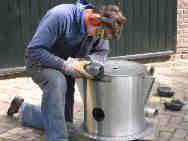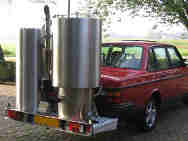
Whenever Dutch John goes into town, which is as seldom as possible, he tends to walk or take the bike.
He describes himself as a “low profile anarchist and an off-gridder in the broadest senses of the word”. But it’s not just his environmental beliefs that prevent him from taking the car.
Every time he uses his twenty year old Volvo 240, first he has to clean up the cyclone bin, dump the char dust on the compost, fill the fuel bin with sixty pounds of wood, stacking a few sacks on the back seat for extra mileage, spark up the gasifier with a diesel glow plug, wait four minutes for it to heat up, flare off the surplus carbon monoxide and hydrogen. And then he’s off.
It’s not exactly a quick getaway. But that, says John, is precisely the point. An automotive engineer by training, he spent a year painstakingly designing and building the stainless steel gasifier mounted on a platform at the rear of his car, which believe it or not, allows common or garden wood to be substituted for petrol.
A wood-powered car? Is John having us on? Apparently not. It is established or rather re-established technology. During the Second World War hundreds of thousands of European cars ran on wood-gas. But when the war ended and gasoline became available again, the wood mobile was consigned to oblivion. Today John’s wood-powered Volvo is one of only a handful in Europe.
“My aim was to make my own fuel to increase my self-sufficiency,” he says. “But the fact that it takes time and effort means that before you drive you really think about each journey, whether you really need it and whether there are better ways of doing it.” He suggests that if the transaction cost of other forms of consumption were higher, we would all be more prudent about what we casually consume.

But once it gets going, apart from the two steel urns looking like a small nuclear reactor in the rear view mirror, (John describes it with pride and just a hint of irony, as “a piece of industrial art,”) you would hardly know that you had just filled up with a load of old pine pallets and oak off-cuts, he says. It has lower energy output and driving is a bit more fiddly, but the performance is all you need.
John doesn’t want to reveal his full name “-contrary to the common modern person, I have no desire to have my face public,” he says.
He reckons his car can cruise at around 100-110 kph with a top speed of 120kph. Fuel consumption approximately is 30 kilos of wood for one hundred kilometres, which is one bin-full. “If you load the back seat, you can extend the range to around four hundred kilometres.”
As a rule of thumb, one pound of wood powers a car for one mile, depending on how the car is driven and the precise nature of the gasifier. Naturally some woods have more energy than others. So Beech is better than Pine.
Although the idea of using wood to power a car sounds extraordinary –evoking visions of Casey Jones shovelling logs into the furnace of his Mercedes, really it’s just another form of solar energy, explains John.
In simple terms the gasifier works by taking wood and thermally cracking it to produce solid ash, soot and wood gas. The wood gas is then filtered for soot/ash particles, cooled and channeled to a conventional engine which needs only minor adjustments to the intake manifold to work.
John, concedes that wood power will never replace petrol –it’s just too clunky and cumbersome. And in any case there is not enough wood in the world for us all to drive at current levels on woodgas. But it does have some serious advantages. For starters it uses easily available fuel found in greatest abundance in places where you are least likely to find petrol (the countryside). This makes it an ideal off-grid power source.
What’s more, while finding your own oil well and refining the petrol may present a technical and financial challenge to most of us, anyone can grow trees. John has a hectare of land around his house and says that’s more than enough to have a productive garden and space to grow all the wood his car and house needs. “The great thing is that wood can be grown easily on spare land –on the worst land that’s useless for anything else,” he says.
In addition wood mobiles have no batteries containing prodigious amounts of embodied energy, they are a renewable energy source and they produce less pollution than a diesel powered car.
Of course wood power has draw backs too. For one thing gasifiers have to be big –weighing up to hundreds of pounds because wood has low energy content –roughly a tenth of petrol or natural gas. There’s the off-putting ten minute ritual of cleaning and filling before every journey, the fact that in truth, woodmobiles are harder to drive than conventional cars and a small issue relating to potentially lethal carbon monoxide leaks from the gasifier.
Overall Dutch John says he is very happy with his wood gasifier. He says it took him 11 months and almost 1,000 hours of work to build, spending fifteen to twenty thousand Euros in all –including the Volvo.
He is clearly fascinated by the potential of gasifiers as alternative powers sources. For instance they can easily be used to power a house. And as a little side project John has also built himself a wood-powered lawn mower and wood-powered electric generator, out of junk materials.
But for him building the gasifier was primarily a political act aimed at increasing the possibility of not engaging with ‘the system’. It’s a way for him to be more self sufficient, both in energy terms and financial. He acknowledges it will never dominate the world, but it gives a glimpse into another way of being, he says.
“Unfortunately wood is not a cutting edge material and our modern, fast paced society does not tolerate a low tech fuel to operate a high tech machine. Obviously these worlds are separated too far and it is not acceptable to unite them. However, woodgas can be produced surprisingly easy. The fact that a combustion engine can run on woodgas is mysterious. Wood is warm, romantic…. wood is magical…..” (www.woodgas.nl)
3 Responses
The Stanly Steamer: Another technology that needs to be revisited.
https://www.stanleymotorcarriage.com/GeneralTechnical/GeneralTechnical.htm
My father told me about these many years ago. He was a member of the OSS in WWII and parachuted into occupied France before D-Day to train the French Underground. This is how they were able to get around besides using a bicicle. Unfortunately, Allied paratroopers in uniform were a bit obvious on a bike.
Good to see them return to popularity.
Love it! I’m going to build one as soon as I’m released from the Institute. I told them that it was possible but they didn’t believe me. Damned space aliens.